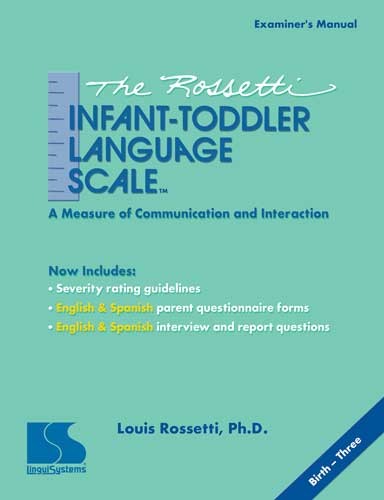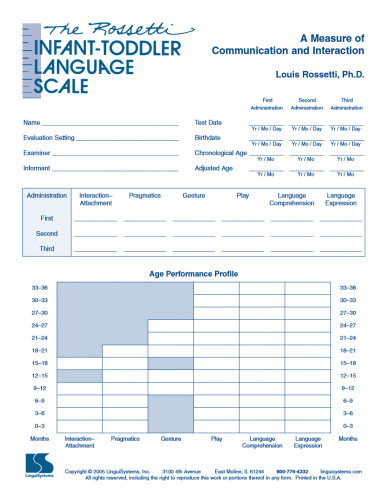The Rossetti Infant-Toddler Language Scale
A Measure of Communication and Interaction
COMPLETE KIT
- Ages 0 - 36 months
- Testing Time Varies
- Administration Individual
-
Product Code 34110 ( MR #065140 )
* Qualifications required to purchase this item. Click here to complete the qualifications form.
Price $138.00
Contents
The Rossetti Infant-Toddler Language Scale is designed to provide the clinician with a comprehensive, easy-to-administer, and relevant tool to assess the preverbal and verbal aspects of communication and interaction in the young child.
The Rossetti Infant-Toddler Language Scale is a criterion referenced instrument that assesses Interaction-Attachment, Pragmatics, Gesture, Play, Language Comprehension, and Language Expression.
Behaviors can be directly elicited from the child, directly observed, or reported by parent or caregiver to credit the child's performance. All carry equal weight when scoring the scale. Results reflect the child's mastery of skills in each of the areas assessed at three-month intervals across developmental domains tested.
The test items guide you in directing and structuring observations in order to monitor the child's progress in language developmental areas. The items are based on a compilation of author observation and descriptions from developmental hierarchies and behaviors recognized and used by leading authorities in the field of infant-toddler assessment. Only items considered discriminating and representative of a skill at an age were included.
Severity rating guidelines help you interpret the results and confidently communicate the severity of the child's delay.
Reproducible Parent Questionnaire and report questions are in English and Spanish.
Subtests
- Interaction Attachment—This subtest assesses the cues and responses that reflect a reciprocal relationship between the caregiver and the child.
- Pragmatics—Assess the way the child uses language to communicate with and affect others in a social manner in this subtest.
- Gesture—This subtest assesses the child's use of gesture to express thought and intent prior to the consistent use of spoken language.
- Play—Assess the changes in a child's play that reflect the development of representational thought with this subtest.
- Language Comprehension—This subtest assesses the child's understanding of verbal language with and without linguistic cues.
- Language Expression—Assess the child's use of preverbal and verbal behaviors to communicate with others.
Examiner Qualifications
The Rossetti Infant-Toddler Language Scale is designed for use by any member of the infant-toddler assessment team or intervention team regardless of primary academic discipline. It may be administered by a single administrator or as part of a multi- or transdisciplinary-team assessment. The examiner(s) should have a thorough knowledge of child development and communication skills.
Test Procedures
- Prior to the assessment, complete and review the Parent Questionnaire and other available information about the child's past and current skills to determine where to begin testing.
- Observe the child in a period of free play or in interaction with the caregiver. Use this information to score items as "observed" on the scale.
- Interact directly with the child to elicit the remaining items on the scale. Begin with Interaction-Attachment, starting six months below the child's chronological age or suspected developmental level.
- Obtain basal and ceiling levels of performance. Repeat this procedure for each developmental area.
- Follow up as necessary by engaging the child in a period of free play to complete the scoring of scale items.
Scoring/Types of Scores
- Test items are considered "passed" if the behavior in question is noted through observation or through direct elicitation. When a behavior is not observed or elicited during the assessment, the caregiver is asked about the behavior. These questions are in the Examiner's Manual in English and Spanish. Observation, elicitation and reporting carry equal weight when scoring.
- A child must demonstrate all behaviors for a particular developmental area within an age range before a developmental age level can be considered mastered rather than emerging.
- Scoring guidelines, suggested questions for caregivers, and testing tips are given for each test item.
- Results reflect the child's mastery of skills in each of the areas assessed at three-month intervals.
- The child's performance is compared to known developmental parameters as opposed to a group of typically developing children.
Discussion of Performance
The Discussion of Performance section found in the Examiner's Manual helps you bridge from assessment to treatment. It was developed to guide the examiner to make appropriate and educationally relevant recommendations for remediation based on the results of the assessment. Includes guidelines for the interpretation and reporting of assessment results; a description of the patterns or rates of change noted as a result of serial assessment; severity rating guidelines for mild, moderate, and severe delay; suggestions for how and when to conduct parent conferences to report test results; and suggestions for how to determine and establish therapy goals.
Standardization
This well-respected test is a criterion-referenced not a normed-referenced instrument. Criterion-referenced tests compare the subject's mastery of the specified behaviors to the specified behaviors.

 Proud to be Canadian
Proud to be Canadian

